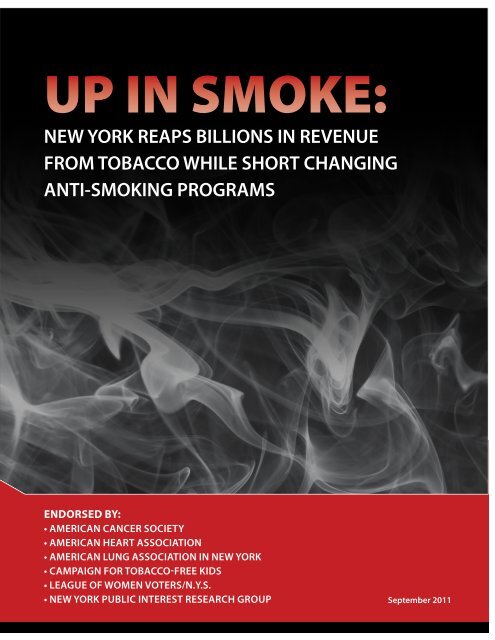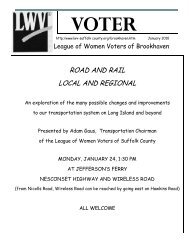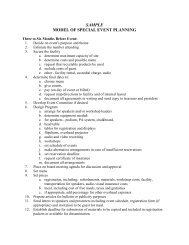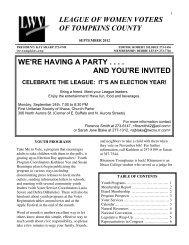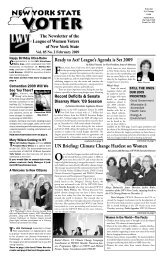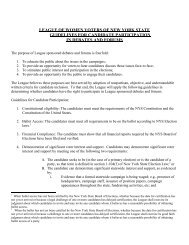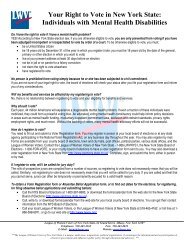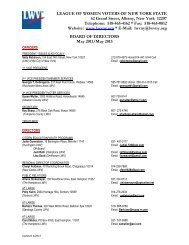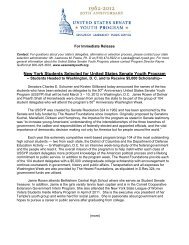UP IN SMOKE: - American Cancer Society
UP IN SMOKE: - American Cancer Society
UP IN SMOKE: - American Cancer Society
Create successful ePaper yourself
Turn your PDF publications into a flip-book with our unique Google optimized e-Paper software.
<strong>UP</strong> <strong>IN</strong> <strong>SMOKE</strong>:<br />
new york reApS biLLionS in reVenue<br />
from tobAcco wHiLe SHort cHAnging<br />
Anti-Smoking progrAmS<br />
EndorsEd by:<br />
• AmericAn cAncer <strong>Society</strong><br />
• AmericAn HeArt ASSociAtion<br />
• AmericAn Lung ASSociAtion in new york<br />
• cAmpAign for tobAcco-free kidS<br />
• LeAgue of women VoterS/n.y.S.<br />
• new york pubLic intereSt reSeArcH group<br />
September 2011
AcknowlEdgEmEnts<br />
Written by Russ Sciandra and Blair Horner of the <strong>American</strong> <strong>Cancer</strong> <strong>Society</strong>, Eastern Division.<br />
The authors thank Lisa Currin, Paul McGee, Jason Plaia, Angela Pause-Smith, and Jennifer Sullivan<br />
from the <strong>American</strong> <strong>Cancer</strong> <strong>Society</strong> as well as Ann Boonn and Meg Riordan from the Campaign for Tobacco-Free<br />
Kids who contributed to this work.<br />
You can download the report, by going to the <strong>American</strong> <strong>Cancer</strong> <strong>Society</strong> website at:<br />
www.cancer.org/nynj<br />
© 2011, <strong>American</strong> <strong>Cancer</strong> <strong>Society</strong>, Eastern Division.
<strong>UP</strong> <strong>IN</strong> <strong>SMOKE</strong>:<br />
new york reApS biLLionS in reVenue<br />
from tobAcco wHiLe SHort cHAnging<br />
Anti-Smoking progrAmS<br />
EndorsEd by:<br />
• AmericAn cAncer <strong>Society</strong><br />
• AmericAn HeArt ASSociAtion<br />
• AmericAn Lung ASSociAtion in new york<br />
• cAmpAign for tobAcco-free kidS<br />
• LeAgue of women VoterS/n.y.S.<br />
written by:<br />
RuSS SCiAnDRA<br />
BLAiR HoRnER<br />
• new york pubLic intereSt reSeArcH group September 2011
1<br />
<strong>UP</strong> In smokE:<br />
EXEcUtIVE sUmmAry<br />
Since 1999, new York has raised billions of dollars in tobacco revenues, largely resulting from several significant increases<br />
in the state’s tax on tobacco products. These hikes in taxes act as an important deterrent to smoking by adults and<br />
children. However, those benefits are severely undercut because the state uses little of those revenues to fund smoking<br />
cessation and anti-tobacco public education programs.<br />
This report examines the inadequacy of new York’s anti-smoking efforts in light of the significant resources available. We<br />
find that only a tiny fraction of revenue the state derives from tobacco use is being used for tobacco control efforts, and<br />
that the state is spending far less than recommended by the federal government. As a result, the potential public health<br />
benefits and savings that would be realized through robust funding of tobacco control programs are going “up in Smoke.”<br />
FIndIngs:<br />
• new York has raised $10.5 billion in tobacco revenues over the past six years, yet less than four percent has been spent<br />
on tobacco control programs. To be clear, only about four pennies of every dollar raised by tobacco taxes goes to help<br />
people quit smoking. This inadequate spending stands in stark contrast to previous promises made by public officials<br />
to invest these state dollars in tobacco control.<br />
• in the current fiscal year, new York will spend on tobacco control only 16 percent of the amount recommended by<br />
the Centers for Disease Control and Prevention. In addition, over the past three years funding for the tobacco control<br />
program has been cut in half.<br />
• Tobacco use takes a terrible toll on new York. in 2009, 25,400 lives were prematurely lost due to tobacco use. in addition,<br />
the state lost an estimated $8.17 billion in health care costs and $2.7 billion in Medicaid costs as a result of tobacco use.<br />
• Tobacco control programs have been proven to reduce youth smoking and help current smokers to quit.<br />
• When more adequately funded, the new York tobacco control programs achieved successes in the effort to curb tobacco<br />
use, especially in preventing young people from becoming smokers. Teenage and adult tobacco use rates have fallen<br />
faster in new York than in the u.S. as a whole. in 2010, 12.6 percent of teenagers, and 15.5 percent of adults, were smokers.<br />
• Limited funding prevents the Tobacco use Prevention and Control Program from reaching the most vulnerable populations<br />
with the highest rates of smoking. increasingly, the burden of tobacco taxes falls most heavily on those least able to pay.<br />
rEcommEndAtIons:<br />
• new York should spend a dime in every dollar of revenue from tobacco sales on tobacco control. new York must<br />
fulfill its promises to use tobacco revenues for programs to help smokers to quit and to keep children from smoking.<br />
We recommend incrementally increasing tobacco program funding to the cdc-recommended level of $254<br />
million per year. The program’s annual budget should be increased to $100 million in 2012-13 and then, as its<br />
capacity grows, increased by $50 million every year until it reaches the target appropriation.<br />
• target more resources to adult cessation. Achieving near-term reductions in tobacco use rates, and the incidence of<br />
tobacco-caused disease, will best be accomplished by encouraging adult smokers to quit and providing resources<br />
to help them succeed. only by motivating smokers to attempt to quit smoking and providing the pressure, resources,<br />
and support to make those attempts successful will near-term smoking rates decline, disease rates decline, premature<br />
deaths decline, and economic savings accrue. Most smokers want to quit, and encouraging and assisting adult<br />
cessation is a cost-effective tobacco control strategy.<br />
• increase community level interventions, especially in disadvantaged urban neighborhoods and rural areas.<br />
To change social norms a program must be well integrated into a community. Program personnel must understand<br />
and, preferably, live in, the communities they work in. At least one-third of any budget increase should be directed<br />
to increasing the level of community activity.<br />
• increase funding for anti-smoking media messages. As quickly as possible, the TCP should increase its media budget<br />
and target messages to those, such as the poor and non-English speakers, that the program has not been reaching.<br />
• develop and implement strategies for reaching those with mental illness or addictive disorders: People with<br />
mental illness smoke at a rate almost twice that of the general public. increasingly, tobacco use is concentrated in<br />
this population, and if the problem is not addressed now, the burden of tobacco use will increasingly fall on those<br />
least able to absorb it.
<strong>UP</strong> In smokE:<br />
In sIX yEArs, tobAcco HAs gEnErAtEd<br />
oVEr $10 bIllIon In rEVEnUEs For nEw york<br />
new York State generates a staggering amount of revenue from tobacco each year. These tobacco revenues come<br />
from two main sources: (1) the state’s tobacco taxes; and (2) monies that result from litigation commenced by<br />
new York against tobacco product manufacturers.<br />
tobAcco tAXEs<br />
new York’s cigarette excise tax is $4.35 per pack. in the fiscal year that ended March 31, 2011, new York State collected<br />
$1.351 billion in taxes on cigarettes and other tobacco products. 1 Moreover, new York includes the excise tax in the<br />
base when calculating the sales tax on cigarettes, and tax revenue from the assessment on the excise tax portion<br />
of the cost alone was approximately $54 million. The City of new York imposes an additional tax of $1.50 per pack<br />
on sales there.<br />
tHE mAstEr sEttlEmEnt AgrEEmEnt<br />
in the same fiscal year, new York State received $391.3 million in Master Settlement Agreement (MSA) payments<br />
from tobacco product manufacturers, 2 bringing total annual revenue from tobacco to $1.796 billion. it is important<br />
to note that most, if not all, of this cost is borne by the consumers of tobacco products in the form of higher retail prices.<br />
The revenue generated from new York’s litigation arises from the MSA, an agreement between the nation’s<br />
largest cigarette companies and 46 states. The MSA requires those cigarette companies to, among other things,<br />
annually pay billions of dollars to the states as compensation for the health costs to their Medicaid programs<br />
resulting from tobacco use.<br />
After the MSA was signed in november 1998, many governors, state attorneys general, and other high-ranking state<br />
officials expressed strong support for investing substantial portions of the tobacco settlement payments in new<br />
efforts to prevent and reduce tobacco use in their states.<br />
For example, Governor Thomas Carper, Chairman of the national Governors Association and utah Governor<br />
Michael Leavitt, Vice Chair, wrote in letter to u.S. Senate Minority Leader Daschle, March 5, 1998:<br />
“The nation’s Governors are committed to spending a significant portion of the tobacco settlement<br />
funds on smoking cessation programs, health care, education, and programs benefiting children.”<br />
Announcing the settlement, then-new York Attorney General Dennis Vacco released a statement on november 16, 1998<br />
which stated:<br />
“As a result, millions of children who are not yet smokers will be spared horrific diseases and suffering,<br />
and millions of current smokers will get a real chance to quit and reclaim their good health.” 3<br />
However, it was not just promises made by high-ranking public officials in press releases. The pledge to use the MSA<br />
revenues to curb tobacco use is found in the agreement itself. Most notably, the MSA begins with a series of<br />
“Whereas” clauses, including the following:<br />
wHereAS, the Settling States that have commenced litigation have sought to obtain equitable relief<br />
and damages under state laws, including consumer protection and/or antitrust laws, in order to further the<br />
Settling States’ policies regarding public health, including policies adopted to achieve a significant reduction<br />
in smoking by Youth …<br />
wHereAS, the Settling States and the Participating Manufacturers are committed to reducing underage<br />
tobacco use by discouraging such use and by preventing Youth access to Tobacco Products;<br />
1 However, taxes on other tobacco products, while high, are not at equal rates to the cigarette tax, making those products more accessible to youth.<br />
2 new York State shares its MSA payments with each county and the City of new York. The state retains 51.2% (in 2010, $391.3 million) of the annual payments.<br />
3 new York State office of the Attorney General, news Release, “Vacco: $200 Billion Tobacco Plan to Protect Health of Kids,” november 16, 1998.<br />
2
3<br />
wHereAS, the undersigned Settling State officials believe that entry into this Agreement and uniform consent<br />
decrees with the tobacco industry is necessary in order to further the Settling States’ policies designed to reduce<br />
Youth smoking, to promote the public health and to secure monetary payments to the Settling States; and<br />
wHereAS, the Settling States and the Participating Manufacturers … have agreed to settle their respective<br />
lawsuits and potential claims pursuant to terms which will achieve for the Settling States and their citizens<br />
significant funding for the advancement of public health, the implementation of important tobacco-related<br />
public health measures, including the enforcement of the mandates and restrictions related to such measures,<br />
as well as funding for a national foundation dedicated to significantly reducing the use of Tobacco Products<br />
by Youth. 4<br />
These excerpts clearly indicate that the states are supposed to use their MSA payments to advance public health and<br />
support tobacco-prevention efforts. indeed, the last clause explicitly says just that, and also very clearly declares that<br />
the states are expected to use their MSA funding for tobacco-prevention and other public health efforts.<br />
However, over 12 years later, the promises to use the settlement monies for tobacco prevention has eroded – or been<br />
ignored.<br />
As seen in the chart below, new York State has raised $10.5 billion in tobacco revenues over the past six years.<br />
Yet during that time, spending to prevent kids from smoking and to help smokers quit has plummeted.<br />
The money is amply available; it is the commitment that is missing.<br />
new york Has raised billions from tobacco and spent little on tobacco control<br />
FIscAl<br />
yEAr<br />
fy 2007<br />
fy 2008<br />
fy 2009<br />
fy 2010<br />
fy 20119 fy 201210 totAl<br />
AmoUnt sPEnt on<br />
tobAcco control 5<br />
(millions)<br />
totAl rEVEnUE<br />
From tobAcco 6<br />
(billions)<br />
rEVEnUE From<br />
tobAcco tAXEs 7<br />
(millions)<br />
$85.5 $1.4 b $980.6<br />
$85.5<br />
$1.4 b<br />
$1 b<br />
$80.4<br />
$1.9 b<br />
$1.4 b<br />
$55.2<br />
$1.8 b<br />
$1.4 b<br />
$58.4<br />
$1.9 b<br />
$1.5 b<br />
$41.4<br />
$2.1 b (est)<br />
$1.7 b<br />
$406.4<br />
$10.5 b<br />
$7.98 b<br />
The MSA also had an effect on the price of cigarettes. Reports at that time cited statements by the largest cigarette<br />
companies that they estimated per pack price increases of 45 cents – the largest price increase up to that date. 11<br />
Coupled with soon-to-be enacted tobacco tax hikes, the cost of smoking was about to go up.<br />
These price increases have impacted tobacco consumption. A paper, 12 examined 523 published estimates of cigarette<br />
price elasticity from the academic literature. it found a median adult short-run price elasticity of 0.40 (long-run elasticity<br />
was 0.44). This means that for every 10 percent increase in price, there is a 4 percent decrease in consumption. About<br />
half the decreased consumption is due to adult smokers quitting, and half is due to smokers who continue smoking<br />
at a reduced rate. in the years since the MSA-caused price increase took effect (and most states raised their cigarette<br />
excise tax, many more than once), tobacco consumption throughout the u.S. has declined.<br />
4 Master Settlement Agreement, november 23, 1998, See: http://www.naag.org/backpages/naag/tobacco/msa.<br />
5 Campaign for Tobacco Free Kids, See: http://www.tobaccofreekids.org/research/factsheets/pdf/0209.pdf.<br />
6 Campaign for Tobacco Free Kids, See: http://www.tobaccofreekids.org/research/factsheets/pdf/0220.pdf.<br />
7 Calculations by authors, subtracted settlement amounts from total tobacco revenues.<br />
8 For settlement payments from FY 2007-2010, See: http://www.tobaccofreekids.org/research/factsheets/pdf/0365.pdf<br />
9 For FY 2011, Source: http://www.tobaccofreekids.org/research/factsheets/pdf/0219.pdf.<br />
10 For 2012, nYS Enacted Budget Financial Plan for Fiscal Year 2012. new York State Division of the Budget. May, 2011.<br />
11 Meier, B. “Cigarette Maker Raises Price 45 Cents A Pack”, The New York Times, october 24, 1998, p. A 20.<br />
12 Gallet, C.A., List, J. A., “Cigarette Demand: A Meta-Analysis of Elasticities”, Journal of Health Economics, V. 12, october 2003, p.821-835.<br />
rEVEnUE From<br />
tobAcco sEttlEmEnt 8<br />
(millions)<br />
$396.7<br />
$427.3<br />
$469.4<br />
$391.3<br />
$370.4<br />
$355 (est)<br />
$2.4 b
<strong>UP</strong> In smokE:<br />
tHE bUrdEn oF tobAcco EXPosUrE In nEw york,<br />
EstImAtEd At $8 bIllIon AnnUAlly<br />
Tobacco kills more than 25,000 new Yorkers every year, more than any other cause. 13 nearly one in every five deaths<br />
is attributable to tobacco use, and more than half a million new Yorkers currently suffer from a chronic illness such<br />
as cancer, cardiovascular disease or chronic obstructive pulmonary disease that was caused by smoking. 14 unless<br />
current trends are changed, 389,000 children under 18 and now living in new York will eventually die prematurely<br />
from diseases caused by tobacco – diseases that can be avoided. 15<br />
Tobacco is a source of considerable revenue to new York State and local governments. unfortunately, it is a source<br />
of even greater costs.<br />
The Centers for Disease Control & Prevention (CDC) estimates new Yorkers spend $8.17 billion annually on direct<br />
medical care to treat smoking caused illness. These costs are concentrated at the two ends of the life span: nursing<br />
home expenses incurred by patients with tobacco-caused lung and cardiovascular diseases, and low birth weight<br />
babies born to mothers who smoke during pregnancy, and include $5.4 billion on tobacco-related Medicaid costs. 16<br />
The state and county governments together pay half of Medicaid costs, with the federal government providing<br />
the other half. new York taxpayers thus pay $2.7 billion to care for Medicaid patients with tobacco-caused illnesses.<br />
in 2010, state and local government revenue from tobacco excise taxes, sales taxes on tobacco products and the<br />
MSA totaled approximately $1.6 billion. Thus, there is a gap of more than one billion dollars, or $154 per household<br />
per year, between tobacco-caused state and local expenditures (for Medicaid alone) and tobacco-generated state<br />
and local revenues.<br />
Tobacco imposes additional costs of more than $6 billion in lost productivity due to acute and chronic illness,<br />
with the consequent reduced economic activity leading to lost tax revenue.<br />
the toll of tobacco Use in new york state, 2009 17<br />
High school students who smoke 14.8% (161,700)<br />
male high school students who use smokeless or spit tobacco 12.2% (females use much lower)<br />
kids (under 18) who become new daily smokers each year 24,100<br />
kids exposed to secondhand smoke at home 1,120,000<br />
packs of cigarettes bought or smoked by kids each year 38 million<br />
Adults in new york who smoke 18% (2,721,100)<br />
Adults who die each year from their own smoking 25,400<br />
kids now under 18 and alive in new york who will ultimately<br />
die prematurely from smoking<br />
13 Centers for Disease Control and Prevention, Best Practices for Comprehensive Tobacco Control Programs - 2007, october 2007, p. 90 (nY), p. 88 (nJ).<br />
See: http://www.cdc.gov/tobacco/stateandcommunity/best_practices/pdfs/2007/BestPractices_Complete.pdf.<br />
14 Hyland A, Vena C, Bauer, J et al: “Cigarette-attributable Morbidity in the united States”. Presented at The <strong>Society</strong> for Research on nicotine and Tobacco Meeting,<br />
Savannah, Georgia, February, 2002.<br />
15 Centers for Disease Control and Prevention, State Data Highlights Report, 2006. http://www.cdc.gov/tobacco/data_statistics/state_data/data_highlights/2006/pdfs/dataHighlights06rev.pdf.<br />
16 Centers for Disease Control and Prevention, State Data Highlights Report, 2006.<br />
17 Campaign for Tobacco Free Kids, See: http://www.tobaccofreekids.org/facts_issues/toll_us/new_york<br />
389,000<br />
Adult nonsmokers who die each year from exposure to secondhand smoke 2,770<br />
Annual health care costs in new york directly caused by smoking $8.17 billion<br />
portion covered by the state medicaid program $5.4 billion<br />
residents’ state & federal tax burden from smoking-caused<br />
government expenditures<br />
$889 per household<br />
Smoking-caused productivity losses in new york $6.05 billion<br />
4
5<br />
The most recent in-depth analysis of smoking behavior in new York 18 shows significant variation in smoking prevalence,<br />
daily consumption and smoking cessation among various demographic groups. Smoking prevalence peaks in the<br />
early 20’s and steadily declines as people grow older. Men are still slightly more likely than women to be regular<br />
smokers, and have higher average consumption. Except for Asians, who smoke at half the rate of the general population,<br />
there are not large differences in the prevalence of smoking among new York’s major ethnic groups. 19<br />
Analysis of the state’s smoking rates find a strong socioeconomic gradient in tobacco use. Smoking prevalence is<br />
highest among the poor: persons with family incomes under $20,000 a year constitute more than one-quarter of the<br />
state’s smokers. Thirteen percent of smokers are on Medicaid and one quarter has no health insurance. 20 People living<br />
in rural areas are significantly more likely to smoke than those living in city centers, with smoking prevalence highest<br />
among under educated, low-income rural individuals. 21<br />
individuals with mental health and/or substance abuse problems have been reported to smoke at significantly elevated<br />
rates, an observation borne out in surveys of new Yorkers. Among those reporting mental health problems (an imperfect<br />
measure of the true picture), more than 36 percent smoke, more than twice the rate of those not reporting problems.<br />
And those with self-reported mental health problems smoke 20 percent more cigarettes per day. 22<br />
The implications of these differences are staggering. There is a 25 year mortality gap between people with behavioral<br />
health conditions and the general public. 23 More alcoholics die of tobacco-caused disease than alcohol-related problems. 24<br />
Many mental health clients are poor, and cigarettes consume a large proportion of their discretionary spending.<br />
Smokers with behavioral health problems respond to the same smoking cessation treatments as the general population<br />
and, like the general population, most want to quit. 25<br />
18 Engelen, M, Farrelly, M, Who’s Smoking in new York?, new York State Department of Health, october 2007.<br />
19 ibid, p 16.<br />
20 ibid, p. 15.<br />
21 ibid, p. v.<br />
22 ibid, pp 32 - 33.<br />
23 Colton, C., Mandersheid, R. “Congruencies in increased mortality rates, years of potential life lost, and causes of death among public mental health clients in eight states.”<br />
Preventing Chronic Disease: Public Health Research, Practice and Policy, 3. 2006.<br />
24 Hurt, R.D., et. al. “Mortality following inpatient addictions treatment.” Journal of the <strong>American</strong> Medical Association, 274(14), 1097 -1103.<br />
25 Schroeder, S. A., Morris, C. D. “Confronting a neglected epidemic: tobacco cessation for persons with mental illness and substance abuse problems.”<br />
Annual Review of Public Health, 31: 16.1 – 16.18. 2008.
<strong>UP</strong> In smokE:<br />
EXPErt rEcommEndAtIons For<br />
tobAcco control sPEndIng In nEw york<br />
in the past three decades, a substantial body of scientific evidence has been developed about how to best reduce<br />
tobacco use in the population. indeed, more is understood about how to change human tobacco use behavior than<br />
is known about impacting most behavior-based health problems.<br />
tobAcco control works<br />
Since 1990, several states, including new York, have for at least a period of time funded comprehensive programs<br />
that implement this body of knowledge in a coordinated way. in a 2007 publication, Ending the Tobacco Problem:<br />
A Blueprint for the nation, the prestigious institute of Medicine of the national Academy of Science concluded,<br />
“The evidence … shows that comprehensive state programs have achieved substantial reductions in the rates of<br />
tobacco use … this is particularly true … when states aggressively funded and implemented their tobacco control<br />
programs.” 26<br />
The best way for a state to substantially reduce tobacco use and its attendant harms and costs is to establish an<br />
adequately funded comprehensive tobacco prevention program employing a variety of effective approaches,<br />
including smoke-free laws and periodic tobacco tax increases. nothing else will compete as successfully against<br />
the addictive power of nicotine and the tobacco industry’s aggressive marketing tactics.<br />
A 2006 study published in the <strong>American</strong> Journal of Health Promotion provides evidence of the effectiveness of<br />
comprehensive tobacco control programs and tobacco control policies. The study’s findings suggest that wellfunded<br />
tobacco control programs combined with strong tobacco control policies increase cessation rates. Quit<br />
rates in communities that experienced both policy and programmatic interventions were higher than quit rates in<br />
communities that had only experienced policy interventions (excise tax increases or secondhand smoke regulations).<br />
This finding supports the claim that state-based tobacco control programs can accelerate adult cessation rates in<br />
the population and have an effect beyond that predicted by tobacco-control policies alone. 27<br />
By itself, a significant increase to a state’s excise tax on cigarettes will directly reduce smoking, especially among<br />
youth. But combining tobacco tax increases with a comprehensive statewide tobacco prevention campaign will<br />
accelerate, expand, and sustain the tobacco use declines in the state, thereby saving more lives and saving more<br />
money, and saving both sooner.<br />
The rise in smokers’ calls to Quitlines following state cigarette tax increases shows how important it is to have<br />
cessation resources available to smokers who wish to quit in response to cigarette tax increases. For example,<br />
after the most recent cigarette tax increases in Michigan (from $1.25 to $2.00 per pack) and Montana ($0.70 to<br />
$1.70), smoker calls to the state smoking Quitlines skyrocketed. in the six months after the tax increase, the Michigan<br />
Quitline received 3,100 calls, compared to only 550 in the previous six months; and in Montana more than 2,000<br />
people called in the first 20 days after the tax increase, compared to only 380 calls per month previously. 28 Likewise,<br />
in Texas and iowa, the numbers of calls to their state Quitlines have been much higher after each increased<br />
their cigarette taxes by $1.00 in 2007, compared to the previous year. 29 Probably the most dramatic example is<br />
from Wisconsin, which received a record-breaking 20,000 calls to its state Quitline in the first two months after its<br />
$1.00 cigarette tax increase went into effect on January 1, 2008 – compared to typically 9,000 calls per year prior<br />
to the tax increase. 30<br />
Experts regard the volume of Quitline calls as only one indicator of cessation activity in the population at large.<br />
For every would-be quitter that calls the Quitline, there are several that make the attempt without the Quitline’s<br />
assistance, and an increase in the number of Quitline calls should be interpreted as a much larger increase in the<br />
total number of smokers attempting to quit.<br />
26 institute of Medicine of the national Academies, Ending the Tobacco Problem: A Blueprint for the nation. Washington, D.C., The national Academies Press, p. 171.<br />
27 Hyland, A, et al., “State and Community Tobacco-Control Programs and Smoking - Cessation Rates Among Adult Smokers: What Can We Learn From the CoMMiT<br />
intervention Cohort?” <strong>American</strong> Journal of Health Promotion 20(4):272, April/March 2006.<br />
28 “Tobacco Tax Pushing Smokers to Quit, State Says,” WMMT News, January 26, 2005; Ecke, R, “Phone Lines Smokin’ With Quit Line Calls,” Great Falls Tribune, January 26, 2005.<br />
29 Souza, M, “Thank you for Smoking,” Longview-news Journal, April 22, 2007; “Calls to Quitline iowa double after cigarette tax raised,” AP, March 22, 2007.<br />
30 Wisconsin Tobacco Quitline, “Calls to Wisconsin Tobacco Quit Line Break All Records,” Press Release, February 28, 2008.<br />
6
7<br />
The evidence is clear – when states increase their tobacco tax, quit attempts and the demand for assistance in quitting<br />
increase, and in many cases, increase dramatically. new York’s high excise tax has clearly impacted consumption, but<br />
increased wide-spread tax evasion, principally through native <strong>American</strong> reservation sales, has at least partially undercut<br />
its public health benefit. 31 The State’s recent success in the courts holds promise of a significant reduction in tax<br />
avoidance and an increase in the effective price of cigarettes. But there is also evidence that, independent of policy<br />
changes such as higher tobacco taxes, comprehensive programs are effective in reducing smoking rates.<br />
cAlIFornIA. A study in the <strong>American</strong> Journal of Public Health found that both the 25-cent cigarette tax increase<br />
and the state’s anti-smoking media campaign were statistically significant in reducing cigarette sales in California<br />
from 1990 to 1992. Results show that the tax increase contributed to an 819 million pack decline in cigarette sales,<br />
and the anti-smoking media campaign reduced cigarette sales by 232 million packs. 32<br />
mAssAcHUsEtts. A study of smoking declines in Massachusetts found that more than 55% of the declines in<br />
state cigarette sales from 1992 and 1998 were due to the efforts of the Massachusetts Tobacco Control Program.<br />
The study noted that, while other factors, such as rising cigarette prices, contributed to the declines in smoking,<br />
“the single most important factor appears to be the Tobacco Control Program.” 33<br />
orEgon increased its state cigarette tax by 30 cents per pack in 1997 to establish the state’s new Tobacco Prevention<br />
and Education Program. From 1996 to 1998, per capita cigarette consumption declined by 11.3 percent. Discounting<br />
other factors, the u.S. Centers for Disease Control and Prevention (CDC) estimated that slightly more than half of the<br />
decrease was prompted by the tax increase, with most of the remainder likely caused by the state’s comprehensive<br />
prevention program. 34<br />
IncrEAsEd FUndIng EqUAls dEcrEAsEd tobAcco UsE<br />
Tobacco use prevention and control is not cheap. Tobacco use still afflicts more than two and one-half million new<br />
Yorkers, and interventions must reach large numbers of people to have a significant public health impact. Where a<br />
public health benefit has been realized, it has been due to the synergistic impact of multiple, well-funded interventions<br />
and public policies, applied over a period of several years. Experts have stressed the importance of a comprehensive<br />
and balanced intervention that adequately addresses all the vital elements of a tobacco control program.<br />
A recent study published in the <strong>American</strong> Journal of Public Health examined state tobacco prevention and cessation<br />
funding levels from 1995 to 2003 and found that the more states spent on these programs, the larger the declines they<br />
achieved in adult smoking, even when controlling for other factors such as increased tobacco prices. The researchers<br />
also calculated that if every state had funded their programs at the levels recommended by the CDC during that<br />
period, there would have been between 2.2 million and 7.1 million fewer smokers in the united States by 2003. 35<br />
The Campaign for Tobacco-Free Kids estimates that such smoking declines would have saved between 700,000 and<br />
2.2 million lives as well as between $20 billion and $67 billion in health care costs.<br />
The study described above adds to earlier research, using similar methods, which demonstrated the same type of<br />
relationship between program spending and youth smoking declines. A 2005 study concluded that if every state had<br />
spent the minimum amount recommended by the CDC for tobacco prevention, youth smoking rates nationally would<br />
have been between three and 14 percent lower during the study period, from 1991 to 2000. Further, if every state<br />
funded tobacco prevention at CDC minimum levels, states would prevent nearly two million kids alive today from<br />
becoming smokers, save more than 600,000 of them from premature, smoking-caused deaths, and save $23.4 billion<br />
in long-term, smoking-related health care costs. 36<br />
31 Loomis, B., Kim A., nguyen, Q., Farrelly, M., implications of the June 2008 $1.25 Cigarette Tax increase, new York State Department of Health, november, 2010.<br />
32 Hu, T-W, et al., “Reducing Cigarette Consumption in California: Tobacco Taxes vs. an Anti-smoking Media Campaign,” <strong>American</strong> Journal of Public Health, 85:1218-1222, 1995.<br />
33 Farrelly, M, letter to the editor, Boston Globe, December 9, 2002 [Farrelly is a tobacco researcher at the Research Triangle institute in Research Triangle Park, north Carolina].<br />
34 Centers for Disease Control and Prevention, “Decline in cigarette consumption following implementation of a comprehensive tobacco prevention and education program –<br />
oregon 1996 -1998,” MMWR 48(07):140-03, February 26, 1999, http://www.cdc.gov/mmwr/preview/mmwrhtml/00056574.htm.<br />
35 Farrelly, MC, et al., “The impact of Tobacco Control Programs on Adult Smoking,” <strong>American</strong> Journal of Public Health 98:304-309, February 2008.<br />
36 Tauras, JA, et al., “State Tobacco Control Spending and Youth Smoking,” <strong>American</strong> Journal of Public Health 95:338-344, February 2005.
A study published in the Journal of Health Economics found that states with the best funded and most sustained<br />
tobacco prevention programs during the 1990s – Arizona, California, Massachusetts and oregon – reduced cigarette<br />
sales more than twice as much as the country as a whole (43% compared to 20%). This new study, the first to<br />
compare cigarette sales data from all the states and to isolate the impact of tobacco control program expenditures<br />
from other factors that affect cigarette sales, demonstrates a dose-response relationship between spending on<br />
tobacco prevention and declines in smoking. in essence, the more states spend on tobacco prevention, the<br />
greater the reductions in smoking, and the longer states invest in such programs, the larger the impact. The study<br />
concludes that cigarette sales would have declined by 18% instead of nine percent between 1994 and 2000 had<br />
all states fully funded tobacco prevention programs. 37<br />
ProgrEss stAlls wHEn FUndIng Is rEdUcEd<br />
A 1998 study in the Journal of the <strong>American</strong> Medical <strong>Society</strong> found that California’s progress in reducing adult and<br />
youth smoking stalled when the state cut its tobacco prevention funding in the mid 1990s. Similarly, the impressive<br />
initial declines in youth smoking after Florida began its own state tobacco control program completely stopped<br />
among some age groups and even reversed among others after subsequent funding cuts. 38<br />
tobAcco control Is A good InVEstmEnt<br />
Given the findings regarding the effectiveness of tobacco control program, it is not surprising that other studies<br />
have found that, when adequately funded, the Massachusetts tobacco prevention program was reducing smoking-<br />
caused healthcare costs in the state by $2 for every single dollar spent on the program, and that the longer-running<br />
California program was saving more than $3.50 for every dollar the state spent on the program. 39<br />
Research in California shows that the state’s tobacco prevention program, by reducing the number of low-birthweight<br />
babies, saved the state more than $100 million in healthcare costs in its first seven years. 40 in new York, the cost of<br />
more than half of all births and any complications are paid by Medicaid.<br />
A more recent study of California’s tobacco prevention program found that for every dollar the state spent on its<br />
tobacco control program from 1989 to 2004, the state received tens of dollars in savings in the form of sharp reductions<br />
to total healthcare costs in the state. 41 This study confirms that the cost-saving benefits from sustained state investments<br />
in effective tobacco control programs quickly grow over time to dwarf the state expenditures; producing massive<br />
gains for the state not only in terms of both improved public health and increased worker productivity but in reduced<br />
government, business, and household costs.<br />
comPonEnts oF A modEl tobAcco control ProgrAm<br />
Programs that successfully encourage smokers to quit can produce a more immediate and probably larger public<br />
health benefit than any other component of a comprehensive tobacco control program. Recommendations that<br />
define a comprehensive statewide tobacco control program are provided in the CDC’s Best Practices for Comprehensive<br />
Tobacco Control Programs.” 42<br />
A comprehensive tobacco control program has three main components: (1) mobilizing communities to change<br />
social norms and public policies so that they discourage tobacco use by adults and children, including promoting<br />
smoking restrictions to protect nonsmokers from exposure to second hand smoke; (2) using media and countermarketing<br />
to educate both adults and children about tobacco issues, expose tobacco industry propaganda, and<br />
deglamorize tobacco use; and (3) treating adult smokers’ nicotine addiction. These components are supported<br />
and strengthened by surveillance and evaluation activities and by training and program administrative support.<br />
37 Farrelly, MC, et al., “The impact of tobacco control program expenditures on aggregate cigarette sales: 1981-2000,” Journal of Health Economics 22:843-859, 2003.<br />
38 Pierce, JP, et al., “Has the California Tobacco Control Program Reduced Smoking?,” Journal of the <strong>American</strong> Medical Association (JAMA) 280(10):893-899, September 9, 1998;<br />
Florida Department of Health, 2001 Florida Youth Tobacco Survey, Volume 4, Report 1; october 22, 2001, www.doh.state.fl.us/disease_ctrl/epi/FYTS.<br />
39 Harris, J, “Status Report on the Massachusetts Tobacco Control Campaign, with a Preliminary Calculation of the impact of the Campaign on Total Health Care Spending in<br />
Massachusetts,” 2000; Tobacco Control Section, California Department of Health Services, California Tobacco Control Update, April 2000, www.dhs.ca.gov/tobacco.<br />
40 Lightwood, JM, et.al., “Short-term Health and Economic Benefits of Smoking Cessation: Low Birthweight,” Pediatrics 104(6): 1312 -1320, December 1999.<br />
41 Lightwood, JM et al., “Effect of the California Tobacco Control Program on Personal Health Care Expenditures,” PLOS Medicine 5(8): 1214-22, August 2008,<br />
http://medicine.plosjournals.org/perlserv/?request=getdocument&doi=10.1371%2Fjournal.pmed.0050178.<br />
42 Centers for Disease Control and Prevention, Best Practices for Comprehensive Tobacco Control Programs, Atlanta, GA: u.S. Department of Health and Human Services (HHS), october 2007,<br />
http://www.cdc.gov/tobacco/tobacco_control_programs/stateandcommunity/best_practices<br />
8
9<br />
in a comprehensive program, these individual program elements (and additional effective interventions which may<br />
be identified) work together to prevent and reduce tobacco use. Reducing the broad social acceptability of tobacco<br />
use necessitates changing many facets of the social environment in which tobacco products are used and marketed.<br />
This scale of societal change is a complex process that must be addressed by multiple program elements working<br />
together.<br />
inadequately supported interventions have been shown to have little or no effect. Tobacco control is analogous to<br />
treating an infection: sufficient dose of the right medicine must be applied for a sufficient duration of time in order<br />
to succeed.<br />
The CDC’s Best Practices document lays out how a comprehensive tobacco control program can be operationalized<br />
as a state program. using evidence-based analysis of existing comprehensive state tobacco control programs and<br />
published evidence-based practices, the CDC provides guidance on the scale of funding necessary to support an<br />
effective tobacco control program, and presents state-specific funding ranges and programmatic recommendations.<br />
it estimates that new york should spend between $155.1 million and $339.4 million every year on its comprehensive<br />
tobacco control program, with a median recommendation of $254 million. 43 Approximately a dime of every dollar<br />
of the annual revenue generated by tobacco would fund new York’s tobacco control program at the median CDCrecommended<br />
level.<br />
The CDC’s Best Practices includes a detailed breakdown of programmatic spending within a tobacco control program.<br />
The following chart presents CDC’s recommended funding level for each program element versus the reality of the<br />
most recent state budget. 44<br />
IntErVEntIon<br />
cdc rEcommEndAtIon<br />
(millions)<br />
totAl $254<br />
StAte And community<br />
HeALtH communicAtion<br />
ceSSAtion<br />
SurVeiLLAnce And eVALuAtion<br />
AdminiStrAtion And mAnAgement<br />
$89.9<br />
$66.1<br />
$65.1<br />
$22.1<br />
$11.1<br />
rEAlIty:<br />
ny Fy 2011-12<br />
$41.4<br />
$17.5<br />
$6.0<br />
$10.7<br />
$3.25<br />
$3.9<br />
43 Centers for Disease Control and Prevention. Best Practices for Comprehensive Tobacco Control Programs - 2007. Atlanta: u.S. Department of Health and Human Services,<br />
Centers for Disease Control and Prevention, national Center for Chronic Disease Prevention and Health Promotion, office on Smoking and Health; october 2007, p. 54.<br />
See: http://www.cdc.gov/tobacco/stateandcommunity/best_practices/pdfs/2007/BestPractices_Complete.pdf<br />
44 ibid. p. 54, 55.
<strong>UP</strong> In smokE:<br />
nEw york’s sPEndIng on ProgrAms<br />
to HElP smokErs to qUIt And kEEP kIds From smokIng<br />
new York’s Tobacco use Prevention and Control Program is supported through annual state budget appropriations.<br />
Funding started in 2000 at $32.5 million, peaked in 2006/07 at $85.485 million, and has since precipitously<br />
declined to $41.415 million in the current fiscal year. Spending is now lower than it was in the program’s first full<br />
year of operation. 45<br />
Annual tobacco Program Funding<br />
millions of $<br />
90<br />
80<br />
70<br />
60<br />
50<br />
40<br />
30<br />
20<br />
10<br />
0<br />
32.5<br />
2000<br />
42.5 42.5 40.975 39.45<br />
44<br />
85.485 85.485 80.422<br />
55.125 58.415<br />
cUrrEnt commUnIty-bAsEd ActIVItIEs<br />
nY TCP funds organizations across the state to work in three modalities: Community Partnerships for Tobacco<br />
Control, Youth Action Programs (called “Reality Check”), and Tobacco-Free School Policy Programs. 46 Partnerships<br />
are charged with engaging, educating and mobilizing the community to strengthen tobacco-control policies.<br />
State and community interventions have long been an integral part of a comprehensive tobacco control program,<br />
and are a key element identified in the CDC’s Best Practices. Every county in the state falls within the coverage<br />
area of a Partnership contractor.<br />
Modality contractors are charged to effect policy change in multiple settings, including health care provider<br />
organizations; schools; licensed tobacco retailers; multi-unit housing; and public spaces, such as parks, beaches,<br />
and building entrance ways. A key indicator for this strategy is the adoption and effective implementation of local<br />
and statewide policies that permanently change society’s acceptance of tobacco use and tobacco product marketing.<br />
CDC recommends that tobacco control programs emphasize tobacco regulation and policy over individually<br />
focused clinical or education interventions because policy changes potentially have the greatest reach.<br />
For this strategy to have a meaningful effect on population-based measures of smoking initiation and cessation,<br />
two conditions must be met. First, the targeted policies must cover a significant proportion of the state’s population.<br />
Second, the policies must either provide meaningful support for smoking cessation and prevention or constraints<br />
on the tobacco industry (e.g., reduce cigarette price promotions).<br />
Community contractors conduct three types of activities. They use paid and earned media and other strategies<br />
to raise awareness and educate the community and key community members about the tobacco problem and<br />
tobacco control policies; educate government policy makers about the tobacco problem; and advocate with<br />
organizational decision makers, such as tobacco retailers, health care organizations, school boards, and community<br />
organizations, for policy changes and resolutions.<br />
41.415<br />
2001 2002 2003 2004 2005 2006 2007 2008 2009 2010 2011<br />
45 information provided by new York State Department of Health, Tobacco use Prevention and Control Program.<br />
46 RTi international, 2010 independent Evaluation Report for the new York Tobacco Control Program, new York State Department of Health, August 2010.<br />
10
11<br />
While community coalitions can point to many successes, their impact has necessarily been limited by their ability to<br />
penetrate communities. Rural areas and disadvantaged neighborhoods are especially time and effort-intensive, and<br />
it is doubtful that the program has enough boots on the ground to impact a high proportion of the state’s population.<br />
Clearly at least some, and arguably all, areas of the state are under served in that there is simply not enough person<br />
power working on the project.<br />
cUrrEnt cEssAtIon EFForts<br />
The TCP funds Cessation Centers to increase the number of health care providers that have a system to screen all<br />
patients for tobacco use, provide brief advice to quit at all visits, and provide assistance to help patients quit successfully.<br />
Evidence demonstrates that brief advice to quit smoking by a health care provider significantly increases the odds<br />
that a smoker will quit. Cessation Centers use the Public Health Service clinical practice guideline Treating Tobacco<br />
use and Dependence to guide their work. Cessation Centers partner with health care organizations across new York<br />
State and offer provider training, guidance on system improvement, and technical assistance to bring new organizations<br />
on board, including providing continuing education credits for tobacco cessation training. in 2010, Cessation Centers<br />
across new York State report working with 660 hospitals or hospital departments or units, 1,588 group practices, and<br />
176 other organizations. 47<br />
The new York State Smokers’ Quitline provides individualized phone counseling seven days a week, prerecorded<br />
messages covering a range of stop-smoking topics; a Fax-to-Quit health care provider referral program; the Quitsite<br />
Web site; and the distribution of free 2-week nicotine patch starter kits to eligible callers. Quitlines and Web-based<br />
quitsites serve a number of purposes in a tobacco control program, including (1) providing an effective, evidencebased<br />
service for helping smokers quit smoking; (2) serving as a clearinghouse of information on smoking cessation<br />
for smokers, health care providers, and the general public; (3) providing a call to action in mass media messages<br />
designed to promote cessation; and (4) enabling health care providers to refer their patients to a helpful resource.<br />
The core service of the Quitline is to provide support to those who call seeking to quit. The support is provided by a<br />
Quitline specialist who works with the smoker to develop a quit smoking plan, assess eligibility for and provide nRT,<br />
and send the smoker a packet of quit smoking information. The specialist contacts the caller again to offer encouragement,<br />
provide additional tips, and determine quit progress. The Quitline also offers additional coaching calls and nRT for<br />
Medicaid recipients and the uninsured.<br />
in 2009, 110,724 current and former smokers (4.1% of adult smokers in new York State) received telephone counseling<br />
and 90,966 (3.4%) registered to receive free nRT through the Quitsite. utilization of Quitline services is very much a<br />
function of public awareness created by advertising. The volume of calls increases and decreases as the program’s<br />
advertising increases or decreases. 48<br />
cUrrEnt PUblIc EdUcAtIon EFForts<br />
The program invests in media (primarily television) messages targeting general audiences and smokers. The messages<br />
have addressed the dangers of smoking and the benefits of quitting, the dangers of second hand smoke, and the<br />
adverse impact of tobacco product marketing. Most messages new York uses were produced by tobacco programs in<br />
other states or other countries (including Australia and the united Kingdom), which means new York spends relatively<br />
little of its media budget on production, and most on message delivery. The City of new York has independently produced<br />
and aired anti-smoking messages on media in the city. The quality of new York’s anti-tobacco advertising has won<br />
praise from marketing and public health experts, but in recent years the program’s budget has been too limited to<br />
effectively deliver messages to the public.<br />
Between 2003 and 2007, as funding for the overall program rose, the level of spending devoted to purchasing advertising<br />
time/space increased. Then, in 2008, as the program’s budget began shrinking, spending on mass media also declined.<br />
Gross rating points (GRPs) represent a standardized measure of a television audience’s potential exposure to a media<br />
campaign. overall, advertising increased fivefold from 2003 (21,959 GRPs) to 2007 (109,692 GRPs) and nY TCP’s increased<br />
investment in mass media translated into significant increases in new Yorkers’ awareness of advertisements over time.<br />
Confirmed awareness of nY TCP–sponsored advertisements among new York smokers increased from 6 percent in<br />
2003 to 53 percent in 2007. 49<br />
47 RTi international, 2010 independent Evaluation Report for the new York Tobacco Control Program, new York State Department of Health, August 2010, p.19.<br />
48 RTi international, 2010 independent Evaluation Report for the Tobacco Control Program, new York State Department of Health, p. 26.<br />
49 RTi international, 2010 independent Evaluation Report for the Tobacco Control Program, new York State Department of Health, p. 15
confirmed Awareness of ny tcP television Advertisements and<br />
Annual gross rating Points (grPs), Adult tobacco survey 2003-2009<br />
confirmed Awareness<br />
100 %<br />
80 %<br />
60 %<br />
40 %<br />
20 %<br />
0 %<br />
6 %<br />
6 %6 %<br />
19 %18%<br />
30%<br />
20 %<br />
28 %<br />
39 %<br />
31 %<br />
30 %<br />
36 %<br />
45 %<br />
43 %<br />
53 %<br />
34 %<br />
32 %<br />
39 % 43 %<br />
42 %<br />
45 %<br />
overall nonsmokers Smokers population-weighted grps<br />
However, as the program began absorbing budget cuts, overall GRPs declined by 32.5 percent between 2007 and<br />
2008, and there was a pronounced decline in awareness among smokers from its peak of 53 percent in 2007 to<br />
39 percent in 2008. The decline in awareness coincides with the decline in advertising GRPs purchased in 2008.<br />
Media spending and awareness increased briefly in 2009, but since then, deeper budget cuts have further eroded<br />
the program’s advertising spending and its ability to reach smokers with life-saving information. Furthermore, the<br />
lack of resources has made it harder to field communications targeting racial and ethnic minorities, non-English<br />
speakers and other hard to reach audiences.<br />
PUblIc HEAltH bEnEFIt oF nEw york’s tobAcco control ProgrAm<br />
new York’s tobacco control program, combined with policy measures including a high tobacco excise tax and<br />
public smoking restrictions, has fostered a decline in the rate of tobacco use among both children and adults.<br />
Between 2000 and 2010, the prevalence of smoking among high school students fell steadily from 27.1 percent<br />
to 12.6 percent, a significantly faster rate than observed in the rest of the country. 50<br />
Similarly, the adult smoking rate in new York has also fallen faster than in the u.S. as a whole, dropping from<br />
21.6% in 2003 to 15.5% in 2010.<br />
15,000<br />
12,000<br />
50 new York State Department of Health. “Smoking among new York high school students continues to decline”. Stat Shot, V4, no. 1. January 2011.<br />
9,000<br />
6,000<br />
3,000<br />
note: Statistically significant upward trend from 2003-2009 among smokers, nonsmokers, and adults over all.<br />
Adult smoking Prevalence: ny vs. Us<br />
Percentage smokers<br />
30<br />
25<br />
20<br />
15<br />
10<br />
5<br />
0<br />
21.6<br />
21.6<br />
20.9 20.9 20.8<br />
19.9<br />
2003 2004<br />
20.5<br />
18.2<br />
19.7<br />
20.5<br />
18.9 17.9<br />
16.8<br />
0<br />
20.6<br />
national Health interview Survey nyS brfSS Survey<br />
Population-weighted grPs<br />
19.4<br />
15.5<br />
2005 2006 2007 2008 2009 2010<br />
12
13<br />
However, a closer analysis of the adult numbers shows that a large proportion of the excess decline in adult tobacco<br />
use is due to declines in smoking among those in their 20’s. The prevalence of former established smokers, an indicator<br />
for the role of smoking cessation, has remained unchanged since 2000, with the exception of 25- to 34-year-olds.<br />
The prevalence of adults who have not smoked 100 cigarettes in their lifetime, an indicator for the role of prevention,<br />
significantly increased. This is an indication that the observed reduction in current cigarette use among young adults<br />
is driven by prevention efforts. in other words, the state has succeeded since 1999 in significantly increasing the<br />
proportion of children who do not grow up to become smokers, but has only marginally increased the rate of smoking<br />
cessation among established adult smokers. 51<br />
The decline in smoking has occurred about equally across all ethnic groups. There is now no significant difference<br />
among new York’s major racial/ethnic groups in the adult prevalence of smoking.<br />
Adult Prevalence of smoking by racial/Ethnic group, 2000-2010 52<br />
35 %<br />
30 %<br />
25 %<br />
20 %<br />
15 %<br />
10 %<br />
5 %<br />
0 %<br />
22.6 %<br />
15.9 %<br />
21.6 %<br />
14.2 %<br />
18.1 %<br />
16.0 %<br />
20.4 %<br />
white black Hispanic other<br />
2000 2010<br />
But the program has failed to have any impact on less educated, poorer segments of society. Smoking among those<br />
with less than a high school education was unchanged between 2000 and 2010, a period during which tobacco use<br />
significantly declined among all other groups with higher educational attainment. Those with less than a high school<br />
education now smoke at a rate three times that of college graduates.<br />
12.8 %<br />
Adult Prevalence of smoking by Education, 2000-2010 53<br />
35 %<br />
25 %<br />
15 %<br />
5 %<br />
-5 %<br />
23.9 % 24.0%<br />
Less HS<br />
26.6 %<br />
22.3 %<br />
HS/ged<br />
2000 2010<br />
23.7 %<br />
18.2 %<br />
Some post HS<br />
14.2 %<br />
college degree<br />
51 new York State Department of Health. Youth Prevention and Adult Smoking in new York. March 2011.<br />
52 information from new York Department of Health, Tobacco use Prevention and Control Program.<br />
53 information from new York Department of Health, Tobacco use Prevention and Control Program.<br />
8.2 %
Since 2000, smoking cessation rates have been greater, and smoking rates are now lowest, among new Yorkers<br />
with incomes over $35,000 a year. Those with incomes below $25,000 have the highest smoking rates, and<br />
smoking prevalence among the very poorest are practically unchanged in ten years.<br />
Adult Prevalence of smoking by Income, 2000 - 2010 54<br />
35 %<br />
30 %<br />
25 %<br />
20 %<br />
15 %<br />
10 %<br />
5 %<br />
0 %<br />
23.3 %<br />
22.8 %<br />
< $ 15,000<br />
28.5 %<br />
21.6 %<br />
22.1 %<br />
20.0 %<br />
25.7 %<br />
19.0 %<br />
$ 15,000-$24,999 $ 25,000-$34,999 $ 35,000-$49,999<br />
2000 2010<br />
inadequate funding can substantially weaken the effectiveness of a tobacco control program. The poor are<br />
heavier consumers of mass media, especially television and radio, and can be reached through these channels.<br />
on those brief occasions when the TCP has conducted media campaigns at a level sufficient to penetrate these<br />
markets, it has experienced a significant increase in calls to the Quitline, mostly from lower income smokers.<br />
Because of insufficient funding, the program has not consistently reached the most disadvantaged elements of<br />
society (who can least afford to pay for cigarettes) and has not done enough to help smokers that want to quit.<br />
in 2011, the Legislature adopted recommendations of the Medicaid Redesign Task Force and extended the smoking<br />
cessation counseling benefit to all adult Medicaid beneficiaries. The benefit provides six cessation counseling<br />
sessions within 12 contiguous months and prescription and non-prescription drug therapy (nicotine patches and<br />
gum, bupropion, varenicline). While this is a welcome expansion of the benefit, experience from Massachusetts,<br />
which took a similar step in 2006, shows that utilization of the benefit is directly related to promotion, especially<br />
through the mass media.<br />
17.9 %<br />
12.3 %<br />
$ 50,000 +<br />
54 information from new York State Department of Health, Tobacco use Prevention and Control Program.<br />
14
15<br />
<strong>UP</strong> In smokE:<br />
rEcommEndAtIons: FUnd And ImProVE nEw york’s ProgrAm<br />
obviously, the state’s tobacco control program needs more money. The experts at the CDC recommend it and it is<br />
quite clear that money is available. What is lacking is the will to invest in a program that can significantly reduce<br />
tobacco-caused death and disease, reduce health care costs and enhance the productivity of the state’s workforce.<br />
The repeated cuts to the Tobacco Control Program’s budget prevent it from implementing the type and intensity<br />
of interventions that would make it genuinely comprehensive in scope and impact. Therefore we recommend:<br />
incrementally increase tobacco control program funding to the cdc-recommended level of $254 million per<br />
year. The program’s annual budget should be increased to $100 million in 2012-13 and then, as its capacity grows,<br />
increased by $50 million every year until it reaches the CDC target appropriation.<br />
Even with adequate funding, additional measures are needed.<br />
Additional reforms:<br />
1. target more resources to Adult cessation - it is clear that achieving near-term reductions in tobacco use rates,<br />
and the incidence of tobacco-caused disease, will best be accomplished by encouraging adult smoker to quit.<br />
Treating tobacco dependence in adults is one of 20 priority areas targeted in a recent report from the national<br />
Academy of Sciences identifying ways to transform the healthcare system and translate knowledge into lifesaving<br />
clinical practice. 55 The national Task Force on Clinical Preventive Services ranks tobacco cessation second only to<br />
childhood immunizations in its list of priority preventive services. 56 only by motivating smokers to attempt to<br />
quit smoking and providing the pressure, resources, and support to make those attempts successful will smoking<br />
rates decline, disease rates decline, premature deaths decline, and economic savings accrue. Most smokers want<br />
to quit, and encouraging and assisting adult cessation is a cost-effective tobacco control strategy.<br />
2. increase community Level interventions, especially in disadvantaged neighborhoods and rural Areas -<br />
To change social norms a program must be well integrated into a community. Program personnel must understand<br />
and, preferably, live in, the communities they work in. This can only be done by increasing the number of community-<br />
based TCP contractors working in a coordinated manner to achieve program goals. CDC recommends that about<br />
35% of Program funding be devoted to community activities. The program has done a good job of maintaining<br />
the community interventions it had before budget cuts began, but 35% of such a small budget is not enough to<br />
serve a diverse state of 19 million people. At least one-third of any budget increase should be directed to increasing<br />
the level of community activity.<br />
3. increase the proportion of funding dedicated to Health communications - CDC recommends that 25% of the<br />
Program budget be dedicated to media interventions, but the TCP currently spends only 14% of its budget on<br />
media (much of the difference has been appropriately directed to preserving community programs). This is simply<br />
not enough to effectively reach the general public, let alone develop and implement communication strategies<br />
to reach racial and ethnic minorities, those living in rural areas, non-English speakers and other hard to reach<br />
audiences. As quickly as possible, the TCP should increase its media budget to $66 million a year and target<br />
messages to those the program has not been reaching.<br />
4. develop and implement Strategies for reaching those with mental illness or Addictive disorders - People with<br />
mental illness smoke at a rate almost twice that of the general public. nearly half the cigarettes smoked in the<br />
united States are consumed by people with co-occurring psychiatric or addictive disorders. 57 The new York TCP<br />
has done pioneering work in this field, partnering with the office of Alcoholism and Substance Abuse Services, to<br />
make treatment center smoke free, train addiction counselors in smoking cessation and make nicotine replacement<br />
therapy available to clients. More recently it has worked with the office of Mental Health to begin integrating<br />
tobacco control interventions into mental health systems. Clearly, this is an important initiative that must be<br />
enhanced if we are to eliminate the scourge of tobacco-caused disease. Additional funding should be provided to<br />
the TCP to further support its work with these and other providers serving this and other disadvantaged populations,<br />
such as Federally Qualified Health Clinics and safety net hospitals, with the focus of enhancing support for patients<br />
that use tobacco.<br />
55 institute of Medicine, Board on Health Care Services, Priority Areas for national Action: Transforming Health Care Quality, 2002.<br />
56 Ashley B. Coffield, Michael V. Maciosek, J. Michael McGinnis, Jeffrey R. Harris, M. Blake Caldwell, Steven M. Teutsch, David Atkins, Jordan H. Richland, Anne Haddix,<br />
“Priorities among recommended clinical preventive services”, <strong>American</strong> Journal of Preventive Medicine 21 (1) (2001) pp. 1-9.<br />
57 A Hidden Epidemic: Tobacco use and Mental illness. The Legacy Foundation, June 2011, p 4.


